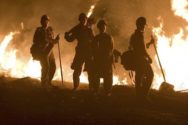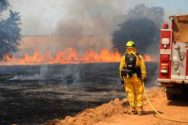
Cannabis farmers battle Emerald Triangle wildfires
Off-Grid cannabis farmers continue to struggle against engulfing wildfires which threaten to destroy their entire crop. More than 200,000 acres of fertile growing land in northern California’s Emerald Triangle has been decimated by the state’s latest string of fatal wildfires, just weeks before the main harvest time and just as they get ready to join the lawful, recreational market.
The fires have hit the Off-Grid cannabis community at a pivotal point in their calendar. October marks the end of the growing season in northern California so most crops have yet to be harvested, potentially resulting in huge financial losses for farmers.
According to ArcView, a cannabis research company, the estimated market value of California’s cannabis industry is thought to be worth around $7 billion and generates between $59 million and $109 million in estimated tax revenue from medical cannabis sales every year. With such large amounts of money potential lost after these most recent wildfires. It is not only the off-grid farmers will begin to feel the pinch. The decline in tax revenues will hurt every citizen in the Emerald Triangle.
One of the worst affected areas is Mendocino County which along with Humboldt County and neighbouring Trinity County form what is known as the emerald triangle. This is essentially the beating heart of the united states cannabis production with over 10,000 square miles dedicated to cannabis cultivation alone. Producing 60 percent of the nation’s cannabis, much of which is currently exported to other states on the black market.
On Thursday the executive director of the California Growers Association, Hezekiah Allen spoke of the disaster saying, “At least seven farms have been destroyed” and that this number is predicted to increase significantly as Off-Grid farmers and locals return to their homes to find their crops in disarray.
Because federal law still considers cannabis as an illegal crop, off-grid farmers find it impossible to cover their crops using traditional insurance. As a result, no bank or institution is willing to work with the industry and so farmers are forced into dealing entirely in cash.
From 2018 Californians will have the right to legally poses, sell and grow cannabis for recreational purposes. This might appear as beneficial to Off-Grid cannabis farmers however with this new wave of legalisation comes larger corporations who plan to capitalise from the relaxed laws. Out competing smaller Off-Grid operations in the Emerald Triangle. Off-Grid cannabis farmers will also be required to pay state or county taxes which is thought could impact the profitability of their businesses.
- Medical Cannabis was legalized in California in 1996
- A Mendocino County commissioned study estimates that two-thirds of the community’s economy comes from marijuana.
- Voters in November 2016 approved the legal sale and possession of an ounce of marijuana for recreational use.
- About 147 million people, 2.5% of the world population, consume cannabis
Recent wildfires …
